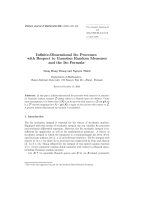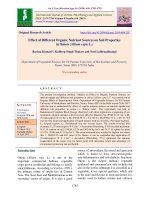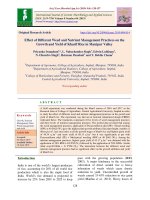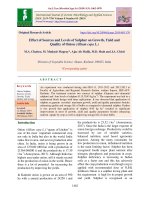Effect of INM in onion (Allium cepa L.) with respect to growth and yield under north Gujarat condition
Bạn đang xem bản rút gọn của tài liệu. Xem và tải ngay bản đầy đủ của tài liệu tại đây (219.3 KB, 5 trang )
Int.J.Curr.Microbiol.App.Sci (2019) 8(4): 1618-1622
International Journal of Current Microbiology and Applied Sciences
ISSN: 2319-7706 Volume 8 Number 04 (2019)
Journal homepage:
Original Research Article
/>
Effect of INM in Onion (Allium cepa L.) with Respect to Growth
and yield under North Gujarat Condition
Raj Kumar Dhakad1*, V.R. Chudasama1, Jitendra Verma2,
Gosae Jalpa1, Mukesh Kumar Dhaked3
1
Department of Vegetable Science, College of Horticulture, Sardarkrushinagar,
Dantiwada Agricultural University, Jagudan, Mehsana-382710, India
2
Department of Agriculture Extension Education, 3Department of Plant Pathology, School of
Agriculture and Rural Development, Dr B. R. Ambedkar University of Social Sciences, Mhow
Indore MP, India
*Corresponding author
ABSTRACT
Keywords
Integrated, Nutrient,
Growth parameters,
Yield parameters
Article Info
Accepted:
12 March 2019
Available Online:
10 April 2019
The present investigation entitled, “Integrated nutrient management in onion (Allium cepa
L.) With respect to growth, yield and quality under North Gujarat condition” was carried
out during rabi season of 2014-2015 at Horticulture Instructional Farm, C. P. College of
Agriculture, Sardarkrushinagar Dantiwada Agricultural University, Sardarkrushinagar. The
growth parameters viz., maximum plant height (43.81cm and 70.46 cm) and neck thickness
(1.53 cm and 2.45 cm) were recorded with treatment T 2 at 45 and 90 DAT respectively
whereas; maximum number of leaves (10.52) was recorded with same treatment at 90
DAT. The same trends were followed in yield and yield parameters viz., maximum weight
of bulb (123.52 g), total bulb yield (19.94 kg/plot and 568.14 q/ha) and marketable yield
(17.51 kg/plot and 499.00 q/ha) were recorded with treatment T 2. Whereas minimum
unmarketable yield of bulb (1.74 kg/plot and 49.66q/ha) was observed with the treatment
T3 and minimum bolting percent (3.30) was obtained under treatment T 6 and T7.
Introduction
Onion (Allium cepa L.) is one of the oldest
bulb crop consumed worldwide. It is one of
the most important commercial vegetable
crops grown in India and believed to be
originated in Central Asia. It is valued for its
distinct pungent flavour and is an essential
ingredient for the cuisine of many regions.
Onion is the queen of the kitchen (Selvaraj,
1976). The onion is preferred mainly because
of its green leaves, immature and mature
bulbs are either eaten raw or cooked as a
vegetable. Mild flavoured and low pungent
bulbs are often chosen for salads. The bulbs
are used in soups, sauces, condiments, spices,
medicines, seasoning of many foods and for
the preparation of value added edible products
like powder and flakes. A distinct
characteristic of onion is its alliaceous odour,
which accounts for their use as food. The
pungency in onion is due to a volatile
compound allyl propyl disulphide.
1618
Int.J.Curr.Microbiol.App.Sci (2019) 8(4): 1618-1622
Onion has many uses as folk medicine and
recent reports suggest that onion plays an
important role in preventing heart diseases
and other ailments. It is one of the richest
sources of flavonoids which reduce risk of
cancer, heart disease and diabetes. Flavonoids
are not only anti-cancer but also known antibacterial, antiviral and anti-allergenic. Onion
contains 11 amino acids. Hundred gram of
raw onion bulb contains about moisture 86.8
g, carbohydrate 11.0 g, protein 1.2 g, fibre 0.6
g, minerals 0.4 g, thiamine 0.08 mg, vitamin c
1 mg, calcium 180 mg, phosphorus 50 mg and
riboflavin 0.01 mg which make up the dry
matter of the bulb (Boss et al., 2003). Onion
is mainly cultivated as a rabi crop, however it
is also raised as kharif in Maharashtra and
Gujarat to catch off-season market.
Onion is a highly nutrient responsive crop.
Conventional methods of fertilization have
undoubtedly helped in improving both bulb
yield and quality. But lately, routine
management practice appears to be incapable
of maintaining yields over the long-term. The
steady depletion of native soil fertility and the
occurrence of multiple nutrient deficiencies in
onion fields have led to the identification of
nutrient management as a key factor limiting
sustainable onion production. Integrated
nutrient management (INM) offers an
effective strategy (Dimri and Singh, 2005). A
gradual shift from using purely organic
sources to introducing some proportion of
inorganic fertilization is gaining acceptance.
This shift has formed the basis for INM,
which could involve two nutrient sources:
inorganic fertilizer and manures. However,
INM further prescribes that selected nutrient
inputs be used judiciously to ensure optimum
supply of all essential nutrients for sustained
crop production.
The organic vegetable industry is flourishing
due to consumer preference organically
produce over traditionally grown vegetables
as a result an increase in varieties and
selection of many vegetables in retail,
supermarket and restaurants.
Materials and Methods
The experiment was conducted at Horticulture
Instructional
Farm,
Department
of
Horticulture, Chimanbhai Patel College of
Agriculture, Sardarkrushinagar Dantiwada
Agricultural University, Sardarkrushinagar,
Gujarat during the rabi season of the year
2014-15. Healthy uniform seedlings having
about 15-20 cm height were used and
transplanting was done at last week of
December with spacing of 15 cm × 10 cm in.
The details of the treatments and treatment
wise application of organic manures and
inorganic fertilizers (kg/ha) are given in Table
1 and Table 2. All the treatments were laid
out in randomized block design with three
replications under drip irrigation.
Impact of organic manures i.e. FYM,
Vermicompost and Poultry Manure along
with nitrogen on growth, yield and qualitative
character of onion (Cultivar Agrifound Light
Red). The soil of the experimental field was
loamy sand texture with pH 7.8, EC 0.16
dSm-1, Available N 215 kg/ha, Available P2O5
37.11 kg/ha and Available K2O 185 kg/ha.
The recommended amount of nitrogen (100
kg N/ha) was applied in four splits i.e. one
fourth was applied as basal and the remaining
dose of N was applied 30,45 and 60 days after
planting. Plant height was measured at 45 and
90 days after transplanting by using scale
method and average of ten tagged plants was
worked out. Number of leaves per plant was
measured at45 and 90 DAT. Bulb diameter
and neck thickness was measured by using
Verniear caliper. Bulb weight and bulb yield
was measured at harvesting stage and yield
was
calculated
as
marketable
and
unmarketable basis. The bulbs were harvested
1619
Int.J.Curr.Microbiol.App.Sci (2019) 8(4): 1618-1622
on maturity when 50-70 % percent neck fall
stage. The number of bolters were counted
from each treatment and worked out in per
cent.
Results and Discussion
The results obtain from the present
investigation on the Evaluation of different
treatments in onion (Allium cepa L.) under
North Gujarat condition during Rabi 2014-15
are discussed given below.
Growth parameters
In the study of all the growth parameters viz.,
maximum plant height, number of leaves and
neck thickness were recorded at the deferent
stages i.e. 45 and 90 DAT.
Among all the treatments, significantly
maximum plant height (cm) at 45 and 90
DAT, number of leaves at 90 DAT and neck
thickness (cm) at 45 and 90 DAT were
recorded with the treatment T2 (125 kg/ha N +
50kg P and K + FYM 20 t/ha) (Table 3).
Table.1 Details of the treatments used for present investigation
Sr.No.
1
2
3
Tr. No.
T1
T2
T3
4
T4
5
T5
6
7
8
9
10
11
T6
T7
T8
T9
T10
T11
Treatments detail
100% NPK as per recommendation (100:50:50) + FYM 20 t/ha
125 kg/ha N + 50kg P and K + FYM 20 t/ha
50% (50kg) recommended dose of N through FYM and 50% (50 kg) recommended dose of
N through chemical fertilizer.
50 % (50 kg) recommended dose of N through vermicompost and 50% (50 kg)
recommended dose of N through chemical fertilizer.
50% (50 kg) recommended dose of N through poultry manure and 50% (50 kg)
recommended dose of N through chemical fertilizer.
100% (100 kg) recommended dose of N through FYM.
100% (100 kg) recommended dose of N through vermicompost.
100% (100 kg) recommended dose of N through poultry manure.
125 kg/ha N through FYM
125 kg/ha N through vermin-compost
125 kg/ha N through poultry manure
Table.2 Treatment wise application of organic manures and inorganic fertilizers (kg/ha)
Treatment
No.
Required quantity (kg/ha)
FY M
T1
T2
T3
T4
T5
T6
T7
T8
T9
T10
T11
Vermi compost
Poultry
manure
20,000
20,000
9613
2933
2177
19228
5866
4222
24022
7333
5422
1620
Urea
SSP
MOP
217.39
271.74
108.79
108.79
108.79
312.5
312.5
312.5
312.5
312.5
312.5
312.5
312.5
312.5
312.5
312.5
83.33
83.33
83.33
83.33
83.33
83.33
83.33
83.33
83.33
83.33
83.33
Int.J.Curr.Microbiol.App.Sci (2019) 8(4): 1618-1622
Table.3 Effect of integrated nutrient management on growth parameters on onion
Sr.
No.
Treatment.
No.
1.
T1
2.
T2
3.
T3
4.
T4
5.
T5
6.
T6
7.
T7
8.
T8
9.
T9
10.
T10
11.
T11
12. S.Em. ±
13. C.D. (P =
0.05)
14. C.V. %
Plant
height
(cm) at 45
DAP
42.30
43.81
33.20
34.64
35.17
28.70
29.12
30.27
31.00
33.51
35.23
1.49
4.39
Plant
height
(cm) at
90 DAP
67.12
70.46
59.46
60.01
64.26
57.62
60.34
61.18
60.65
64.12
65.39
2.48
7.33
Number
of leaves
at 45
DAT
6.20
6.73
6.07
6.53
5.83
5.63
6.07
6.10
6.00
5.57
5.90
0.25
NS
Number
of leaves
at 90
DAT
9.84
10.52
9.12
9.77
9.35
9.45
9.14
9.17
9.82
9.66
9.38
0.27
0.80
7.53
6.86
7.19
4.90
Neck
Neck
Days
thickness thickness taken for
At 45
At 90
maturity
DAT(cm) DAT(cm)
1.32
2.32
124.00
1.53
2.45
123.00
0.98
1.82
125.67
1.07
1.71
125.67
0.87
1.99
124.33
0.79
1.80
124.67
0.98
2.12
123.67
0.93
1.70
125.33
0.74
1.59
124.67
0.77
1.48
124.33
0.86
1.68
124.67
0.058
0.08
1.16
0.17
0.24
NS
10.19
7.38
Bolting
per
cent
1.79
3.43
4.30
3.87
4.03
3.93
3.30
3.30
4.25
4.70
4.03
4.60
0.293
0.87
12.78
Table.4 Effect of integrated nutrient management on yield parameters on onion with BC ratio
Sr.
No.
Treatme
nt. No.
1.
T1
2.
T2
3.
T3
4.
T4
5.
T5
6.
T6
7.
T7
8.
T8
9.
T9
10.
T10
11.
T11
S.Em.
±
12.
13. C.D.
(P=0.05)
14. C.V. %
Weigh
t of
bulb
(g)
114.06
123.52
104.83
107.99
111.52
88.97
96.26
94.49
101.35
111.52
112.84
4.62
13.63
Total
bulb
yield
(kg/plot)
17.67
19.94
15.45
15.72
17.05
14.67
15.13
15.84
15.53
16.89
17.44
0.98
2.89
Total bulb
yield
(q/ha)
Marketable
yield of bulb
(kg/plot)
15.59
17.51
13.71
13.92
15.04
12.64
13.19
13.81
13.43
14.62
15.48
0.90
2.66
Unmarketab
le yield of
bulb
(kg/plot)
2.08
2.42
1.74
1.81
2.00
2.04
1.94
2.03
2.09
2.27
1.96
0.11
0.34
Marketa
ble yield
of bulb
(q/ha)
444.13
499.00
390.46
396.45
428.55
360.03
375.84
393.57
382.67
416.57
441.13
25.65
75.66
503.44
568.14
440.03
448.00
485.63
418.09
431.11
451.38
442.33
481.30
496.85
27.91
82.33
7.54
10.29
10.29
10.79
9.72
10.79
1621
Unmarket
able yield
of bulb
(q/ha)
59.29
69.03
49.66
51.61
57.09
58.06
55.30
57.81
59.65
64.65
55.74
3.24
9.56
Benefi
t Cost
Ratio
9.68 -
5.33
5.98
5.38
5.11
5.80
4.39
4.09
4.69
4.41
4.19
4.91
-
Int.J.Curr.Microbiol.App.Sci (2019) 8(4): 1618-1622
Among all the treatments, minimum bolting per
cent was obtained under treatment T6 (100%
(100 kg) recommended dose of N through
FYM) and T7 (100% (100 kg) recommended
dose of N through vermicompost). These
findings are in accordance with Farooqui et al.,
(2009), Nori et al., (2012) and Nainwal et al.,
(2015).
Yield and yield parameters
In the study of all the yield parameters viz.,
weight of bulb, total bulb yield per plot, total
bulb yield per hectare, marketable and
unmarketable yield of bulb per plot and
marketable and unmarketable yield of bulb per
hectare were recorded under the yield and yield
parameters (Table 4).
Among all the treatments, significantly
maximum weight of bulb (g), total bulb yield
(kg/plot and q/ha) and marketable yield of bulb
(kg/plot and q/ha) were recorded with treatment
T2 (125 kg/ha N + 50 kg P and K + FYM 20
t/ha). Among all the treatments, minimum
unmarketable yield of bulb (kg/plot and q/ha)
was recorded with treatment T3 (50% (50 kg)
recommended dose of N through FYM and 50
% (50 kg) recommended dose of N through
chemical fertilizer) These findings are in
accordance with Farooqui et al., (2009), Nori et
al., (2012), Jamir et al., (2013) and Nainwal et
al., (2015)
The experimental evidences warrant the
following specific conclusion which may be
adopted for profitable cultivation of onion. On
the basis of results of the present investigation,
it could be concluded that nutrient management
in onion is very efficient. Application of 125
kg/h N +50 kg P and K + FYM 20 t/ha should
be applied for getting higher yield and
economic return for North Gujarat Agroclimatic zone.
References
Boss. T. K., Kabir, J., Maity, T.K.(ed), (2003).
Vegetable
crops.
Department
of
Horticulture Bidhan Chandra Krishi
Viswavidyalaya West Bengal. Naya
Udyog Publication Kolkata. Vol. 3 pp 5118.
Dimri, D. C. and Singh, V.P. (2005). Studies
onintegrated nutrient management in
onion. Progresive Horticulture. 37(1):
185-187.
Farooqui, M. A., Naruka, I.S., Rathore, S.S.,
Singh, P.P. and. Shakhawat, R.P.S.
(2009). Studies on effect of nitrogen and
sulphur levels on growth and yield of
garlic (Allium sativum L.). Asian Journal
of agricultural and food science, Special
Issue. S18-23.
Jamir, Singh, V. B., Kanaujia, S.P. and Singh1,
A.K. (2013). Studies on effect of
integrated nutrient management on
growth, yield and quality of onion Allium
cepa L.). Progressive Horticulture. 45(2).
Nainwal, R. C., Singh, D., Katiyar, R.S., Sharma,
L. and Tewari, S.K. (2015). Response of
garlic to integrated nutrient management
practices in a sodic soil of Uttar Pradesh,
India CSIR-National Botanical Research
Institute Journal of Spices and Aromatic
Crops, Vol. 24(1): 33–36
Nori, M., Aali, J. and Reza, Sharifi. (2012). Effect
of different sources and levels of nitrogen
fertilizer on growth, yield and nitrate
accumulation in garlic (Allium sativum
L.). International Journal Agriculture and
Crop Science. 24(4): 1878-1880.
Selvaraj, S. (1976). Onion is queen of kitchen.
Kishan World. 3(12): 32-34.
How to cite this article:
Raj Kumar Dhakad, V.R. Chudasama, Jitendra Verma, Gosae Jalpa, Mukesh Kumar Dhaked. 2019.
Effect of INM in Onion (Allium cepa L.) with Respect to Growth and yield under North Gujarat
Condition. Int.J.Curr.Microbiol.App.Sci. 8(04): 1618-1622.
doi: />
1622









